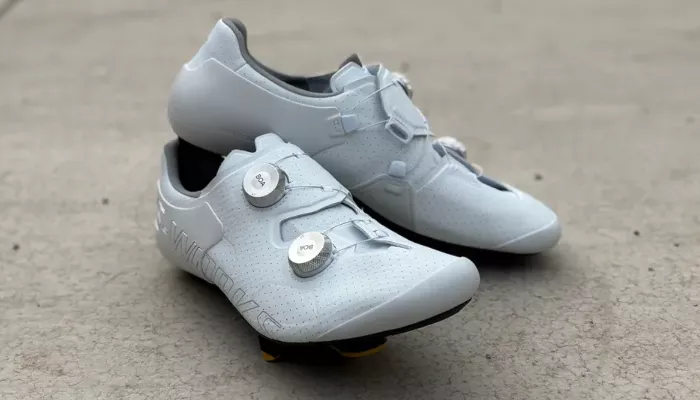Specialized, a dominant player in the cycling industry known for its high-performance bikes, has gained equal recognition for its extensive lineup of components and accessories. From tires to helmets, to shoes and saddles, Specialized-branded products are a staple at group rides around the world. The latest update to its flagship road cycling shoe, the Ares 2, is no exception, drawing attention for its innovative design and steep price tag.
Building upon its predecessor, the Ares 2 retains Specialized’s commitment to maximizing rider comfort and performance through its renowned Body Geometry technology. The shoe, worn by top cyclists like Primoz Roglić, Demi Vollering, and Tim Merlier, promises an enhanced fit aimed at improving power transfer while minimizing pressure points on the foot.
To achieve these improvements, Specialized conducted a comprehensive analysis of over 100,000 3D foot scans, optimizing the foot-to-shoe-to-pedal interaction. The result, according to the brand, is a 7-watt increase in functional threshold power when paired with other Body Geometry components such as custom footbeds and refined cleat positions.
Key design changes focus on ergonomics, with the Ares 2 offering a 20% increase in internal contact surface area and reducing forefoot pressure by 44%. Additionally, the updated design incorporates a new solid heel cup, replacing the previous sock liner, and streamlines branding for a cleaner look. The shoe also features a fresh set of Boa dials, available across three colorways.
However, the most notable shift is the Ares 2’s substantial price increase. Now priced at $600/£479, it stands above most competitors and Specialized’s previous models, making it a considerable investment for cycling enthusiasts. While premium prices are not uncommon in high-end cycling shoes, the Ares 2’s cost still presents a significant hurdle for many riders.
A key selling point of the Ares 2 is Specialized’s Body Geometry philosophy, which aims to optimize rider fit and biomechanics for better performance. The design integrates four core elements: the Varus Wedge, Metatarsal Button, Longitudinal Arch, and Body Geometry Last. These elements work together to improve power transfer by adjusting the foot’s alignment and fit within the shoe.
The Varus Wedge, for example, tilts the shoe 1.5 degrees outward, aligning the knee for more direct power transfer. The Metatarsal Button elevates the foot’s metatarsal bones to avoid discomfort and pinching, while the Longitudinal Arch shape prevents the shoe from acting as a spring, further enhancing power delivery. Finally, the increased footbed space allows the toes to spread more naturally, improving comfort and reducing foot pressure.
Specialized claims that these ergonomic adjustments lead to a 7-watt increase in power at the lactate threshold. However, these optimizations come at the cost of a highly specific fit, which may not suit every rider. In my experience, the shoe’s increased footbed space and firm heel cup led to discomfort, particularly for riders with low-profile feet.
Despite being consistently a size 44, I found my foot swimming in the Ares 2, even with the Body Geometry insoles. Notably, these insoles are sold separately and are essential for riders with high arches, as the stock insoles are not adjustable. Additionally, the firm heel cup caused pinching, which became increasingly uncomfortable on longer rides. After four test rides, I was forced to stop within 45 minutes each time to loosen the Boa dials and relieve the pressure. While I’m optimistic that a smaller size may alleviate some of this discomfort, the experience leaves me cautious about recommending the shoe without a proper fitting.
The Ares 2, while impressive in its design and performance-oriented features, is a shoe that demands careful consideration before purchase. For long-time Specialized users or those accustomed to its specific fit, it offers a premium option at the highest end of the market. However, at $600, it’s a significant investment that may not be suitable for all cyclists, particularly those with wider feet or different foot profiles.
For those interested, I plan to test a size 43 version for a long-term review, hoping to confirm whether the shoe’s performance improvements can justify its hefty price tag. Until then, the Ares 2 remains a high-risk, high-reward option for serious cyclists.
Related topics
- Vingegaard to Miss Volta a Catalunya After Paris-Nice Crash
- Pogačar Releases Limited Edition Strade Bianche T-Shirt
- UK to Host 2027 Tour de France Grand Départ

